Located in the center of the central axis of Beijing, the Palace Museum of Beijing, formerly called the Forbidden City, used to be the imperial palace of 24 emperors of the Ming and Qing dynasties. As an epitome of the best ancient Han Chinese royal architecture, this unrivaled architectural masterpiece is one of the world's largest and best preserved wooden building complexes in existence.

As you walk along the central axis of the Palace Museum, you'll experience a tremendous sense of awe at the sheer magnitude of those magnificent buildings around, capture an air of gentility in royal life from the exquisite furniture set-up in the Six Eastern and Western Palaces and the elaborate garden design in the Inner Royal Court, and get a glimpse into the domestic turmoil and foreign aggression suffered by the old China a century ago from the rolled-up yellow gauze curtains of Dongnuan Pavilion of the Hall of Mental Cultivation which was used as office for handling state affairs by emperors then.
1. History of the Royal Court
The Ming Dynasty (1368-1644) and the Qing Dynasty (1644-1911) were the last two dynasties in China's feudal history. The royal court of the Ming and Qing dynasties was both where the emperors lived and where the highest governing body issued decrees. Dating back to more than 500 years ago as part of the history of the Ming and Qing dynasties, the Ming and Qing royal court was for the convenience of emperors and empresses. Later researches on hierarchy, power struggle, religious rites, and cuisine and clothing of that time not only unfold the colorful yet ruthless life of the Ming and Qing emperors and empresses in more than 500 years, but also reveal the impact of the supreme ruler's statecraft and words and deeds on the fate of the nation and social life.
2. Architecture
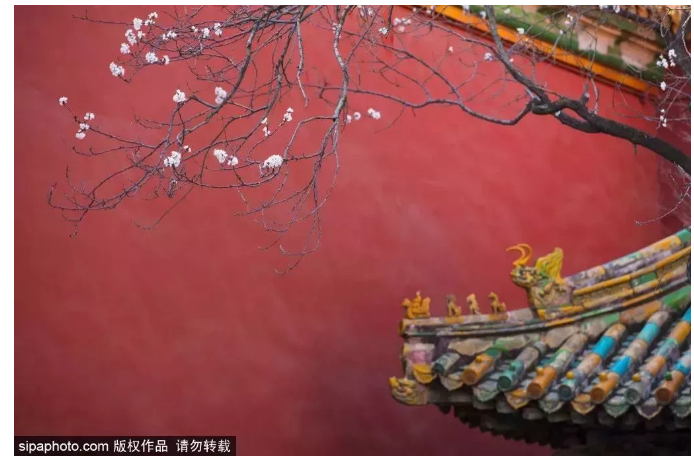
The Forbidden City is 961 meters long from north to south and 753 meters wide from east to west. It is truly an impenetrable defense project, surrounded by walls up to 10 meters high and a moat 52 meters wide. The Forbidden City has four gates: Meridian Gate on its south side, Gate of Divine Prowess on its north side, East Prosperity Gate on its east side and West Prosperity Gate on its west side. A graceful turret is arranged at each of the four corners of the Forbidden City. People then used "nine beams, 18 columns and 72 ridges" to describe the complexity of its structure. The buildings inside are divided into two parts: the Outer Royal Court and the Inner Royal Court. The Hall of Supreme Harmony, the Hall of Central Harmony, and the Hall of Preserving Harmony, collectively referred to as the Three Halls, are the center of the Outer Royal Court as the venues of state ceremonies and celebrations. The Three Halls are flanked by two buildings: Hall of Literary Brilliance and Hall of Martial Valor. The Palace of Celestial Purity, the Hall of Union and Peace and the Palace of Earthly Tranquility, collectively referred to as the three imperial harems, are the center of the Inner Royal Court as the residences of the emperor and his empress. The Imperial Garden is behind them, and the Six Eastern and Western Palaces where the emperor's concubines lived are on both sides. Moreover, there are also an array of Buddhist building complexes around, like the Numinous Firmament Treasure Hall on the east side of the Six Eastern Palaces and the Hall of Rectitude on the west side of the Six Western Palaces. In addition to the Outer Royal Court and the Inner Royal Court, the Forbidden City has two other groups of buildings: Waidong Road and Waixi Road.
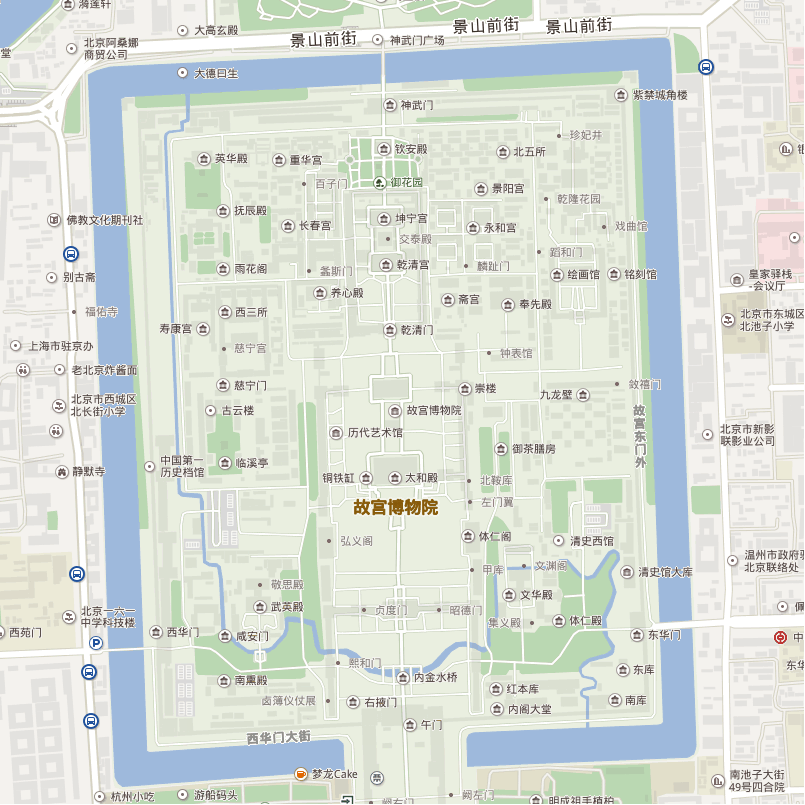
Famous Tourist Attractions
Located in the center of Beijing, the Palace Museum is surrounded by Tian'anmen Gate, Tian'anmen Square, the National Center for the Performing Arts, the National Museum of China, the Working People's Cultural Palace (the Imperial Ancestral Temple), Zhongshan Park (the Altar of Land and Grain), Beihai Park, Jingshan Park, Wangfujing Commercial Street and other famous tourist attractions.
Meridian Gate (the south gate of the Palace Museum that has been used as the visitor entrance only since July 2, 2011) can be reached from Tian'anmen Square via Gate of Correct Deportment, or from East Prosperity Gate or West Prosperity Gate via East Tongzihe Road or West Tongzihe Road.
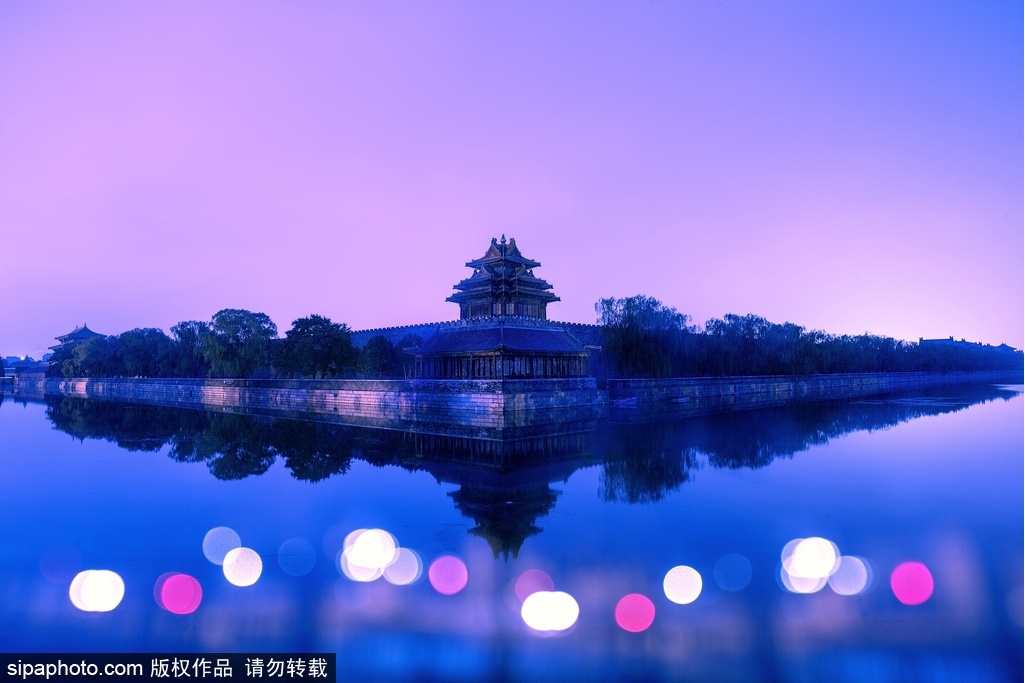
Meridian Gate
Sitting on the north-south axis of the Forbidden City, the Meridian Gate is the main entrance of the Forbidden City. This gate in the middle of the meridian faces the sun, hence the name Meridian Gate. In front of the Meridian Gate are Gate of Correct Deportment, Tian'anmen Gate (the main gate of the imperial city, called Chengtian Gate in the Ming Dynasty), and Great Qing Gate (called Great Ming Gate in the Ming Dynasty); behind it is the Gate of Supreme Harmony (called Fengtian Gate in the Ming Dynasty, renamed Huangji Gate later, and named the Gate of Supreme Harmony in the Qing Dynasty). Inside each gate are two rows of side rooms, each lined up neatly on one side. This progressive layout featuring a square surrounded by the gate and side rooms has something to do with the "five gates, three office buildings" system of ancient China and can highlight the dignity and solemnity of palace buildings.
The Meridian Gate is the main entrance of the Forbidden City. The east, west and north sides connect with each other to form a square in the middle. The gate tower on the north side has nine rooms, covered by a double-eave roof of yellow tiles. Thirteen side rooms are respectively arranged on the east and west city platforms, spreading southward on both sides of the gate tower like the wings of a wild goose, hence the name Tower of Wild Goose Wings. A pavilion with a pyramidal double-eave roof sits on the north and south ends of the East and West Towers of Wild Goose Wings. It looks as if the majestic Meridian Gate were encircled by three mountains and five towering peaks. It is so imposing that it acquired the popular name of Five Phoenix Tower.
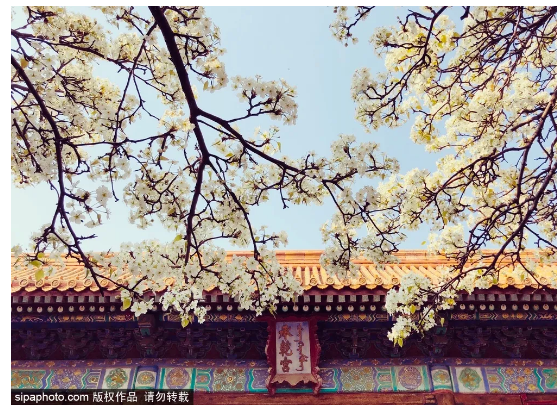
Hall of Longevity
The Hall of Longevity is located on the west side of the garden of the Palace of Compassion and Tranquility and south of the Tower of Auspicious Cloud. It is adjacent to the west wall of the garden and opposite Hanqing Room to the east. This building of gray tiles and black bricks does involve the use of brackets or colored paintings. The decoration is simple and the colors are elegant. Set off by surrounding dense woods in the garden of the Palace of Compassion and Tranquility, it exudes an air of Jiangnan-style architecture. The couplet in front of the hall reads, "The cranes in the pine trees comb their feathers; the bell beyond the courtyard chimes." This incorporates the artistic conception of the building in the extraordinary, refined appeal of the garden of the Palace of Compassion and Tranquility. The Hall of Longevity was built at the same time as Hanqing Room. It was used by Qianlong Emperor to wait upon the Empress Dowager or mourn the death of ancestors. In the late Qing Dynasty, Xianfeng Emperor had meal here while paying respect for Buddha in the Hall of All Peace in the decree of the Empress Dowager. The building is now in good condition.
The Gate of Supreme Harmony and the Three Halls (the Hall of Supreme Harmony is commonly known as the Hall of Golden Chimes)
The Gate of Supreme Harmony (the largest palace gate in the Forbidden City and the main gate to the Outer Royal Court)
The Hall of Supreme Harmony (the Hall of Golden Chimes)
The Hall of Preserving Harmony (the final imperial examination presided over by the emperor was held here every three years)
The Hall of Central Harmony (the place where emperors of ancient China examined and approved elegiac addresses or had a temporary rest)
The Palace Museum is made up of the Outer Royal Court and the Inner Royal Court. Architecturally, the Inner Royal Court is markedly different from the Outer Royal Court. The Outer Royal Court, with the Hall of Supreme Harmony, the Hall of Central Harmony and the Hall of Preserving Harmony as its center, was the place where feudal emperors exercised their powers and held grand ceremonies. The Hall of Supreme Harmony, commonly known as the Hall of Golden Chimes, is one of the Three Halls at the heart of the Forbidden City.
The Hall of Supreme Harmony, with its red walls, yellow tiles, red columns and golden door panels, is resplendent and magnificent in the sun. It is the most spectacular building in the Forbidden City and the largest wooden hall in China.
The Hall of Central Harmony is located between the Hall of Supreme Harmony and the Hall of Preserving Harmony in the Forbidden City. It was where the emperors rested before going to the Hall of Supreme Harmony to attend grand ceremonies and where the officials paid homage to him.
The Hall of Preserving Harmony, located behind the Hall of Central Harmony, was originally built in the 18th year (1420) of the Yongle era of the Ming Dynasty with the name of the Hall of Self-Discipline. Later, it was damaged in a fire during the reign of Jiajing Emperor (1522–1566), and was rebuilt and renamed Jianji Hall. In the second year of the Shunzhi era of the Qing Dynasty, it was renamed the Hall of Preserving Harmony to send the message that "concentration ensures harmony in the universe, a blessed happy life, and peace under the sky." The four characters "huang jian you ji" on the plaque in the Hall of Preserving Harmony was inscribed by Qianlong Emperor to allude to "The monarch must adopt a mean approach to political affairs" written by Ji Zi in the Great Plan (Hong Fan), a chapter of the Book of Documents.
East Prosperity Gate
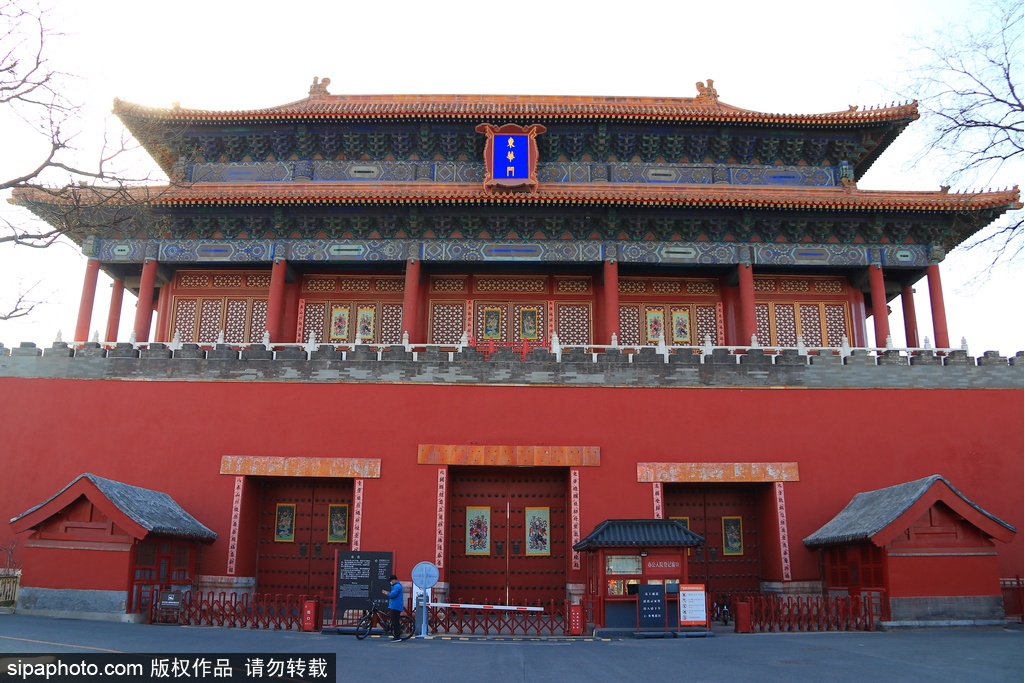
East Prosperity Gate is the east gate of the Forbidden City. It was built in the 18th year (1420) of the Yongle era of the Ming Dynasty. East-facing East Prosperity Gate is opposite West Prosperity Gate. Outside it is a stele for dismounting from the horse; the Golden Water River inside the gate flows in a south-north direction; a stone bridge spans the river; to the north of the bridge are three gates. To the west of East Prosperity Gate is the Hall of Literary Brilliance, and to the south is the Imperial Carriage Warehouse. East Prosperity Gate and West Prosperity Gate are of the same design—both have a rectangular shape, a red city platform, a white jade Buddha statue base, and three garrison gates in the middle that have a square entrance but a round space inside. Atop the city wall is a gate tower with a double-eave roof of yellow glazed tiles and a base encircled by white marble railings. The gate tower comprises five horizontal rooms and three vertical rooms surrounded by corridors. The square columns are painted with colored patterns of hedge glorybind flowers. The "East Prosperity Gate" plaque under the eastern eaves was originally written in Manchu, Mongolian and Chinese. Later, the number of languages in use was reduced to two: Manchu and Chinese. Only copper Chinese characters remained after the Xinhai Revolution.
East Prosperity Gate was opened to the public for the 90th anniversary of the Palace Museum. Across the moat is Donghuamen Street, a gathering place of delicacies from across the country.
3. Millions of Valuable Collections
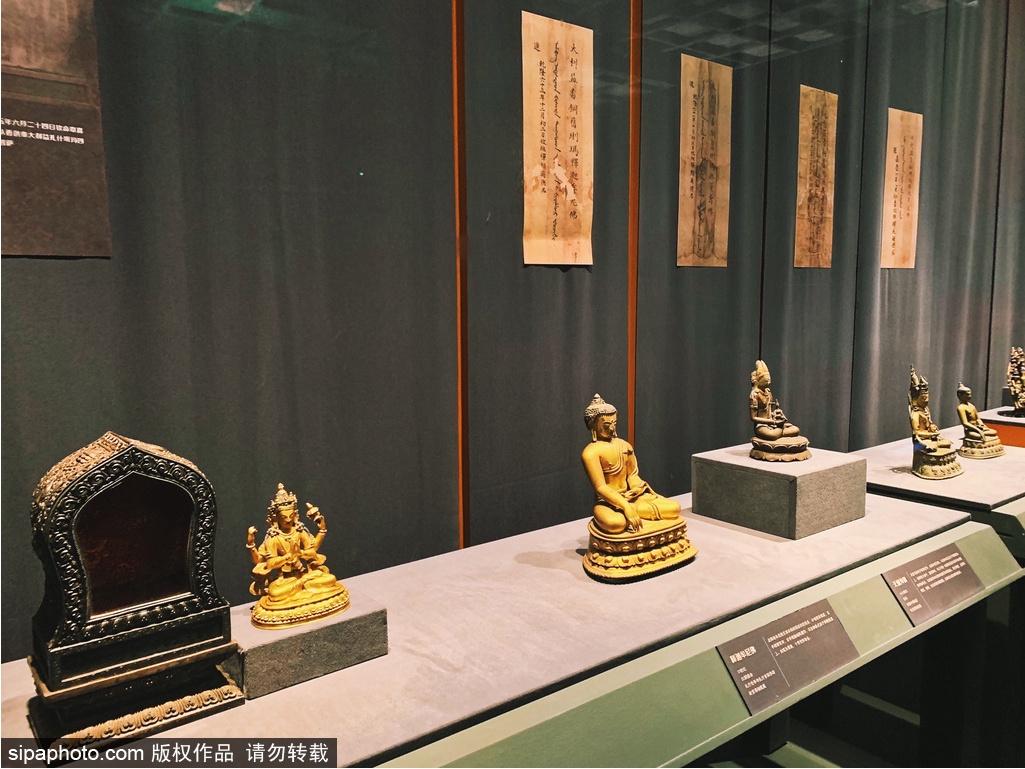
In the past one hundred years or so, the Palace Museum has not only meticulously kept the royal palaces and old treasures left over from the Ming and Qing Dynasties, but also greatly enriched the collection of cultural relics through state allocation, public acquisition and private donation, assembling a valuable collection of more than 1.8 million ancient calligraphy works and paintings, ancient implements, palace cultural relics, books and archives, and others. The permanent cultural relics dedicated hall and the frequent thematic cultural relics exhibitions of the Palace Museum will let you gain a more complete understanding of the great achievements of the Chinese nation in arts and crafts.
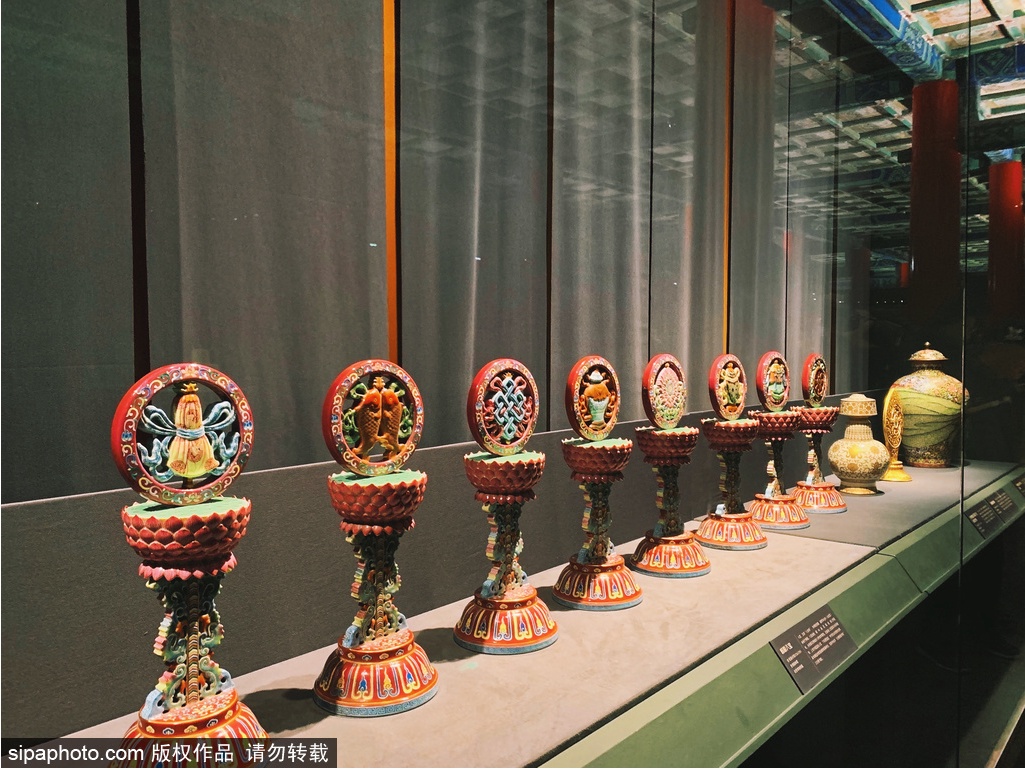
The "Palace Museum" is not only an institution for the protection and management of the building groups and palace cultural relics of the Ming and Qing Imperial Palace (Forbidden City), but also an organization for the collection, research and display of ancient Chinese cultural and artistic works represented by collections of the relics of the Ming and Qing royal families. The "Palace Museum" houses a complete range of excellent cultural relics of ancient times and the modern day. Currently, the Palace Museum has a collection of well over 1.8 million pieces (sets), most of which are palace cultural relics, ancient architecture and books of the Ming and Qing dynasties. These objects fall into 25 broad categories, of which more than 8,000 pieces (sets) are class-I relics, so the Palace Museum is justifiably a treasure house of art.
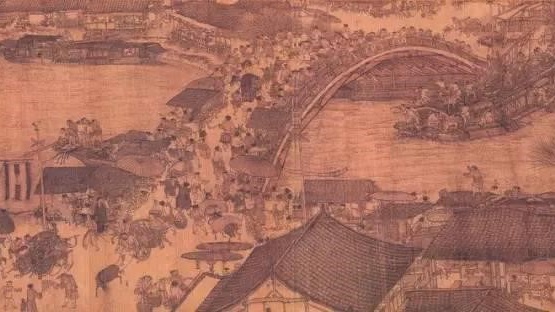
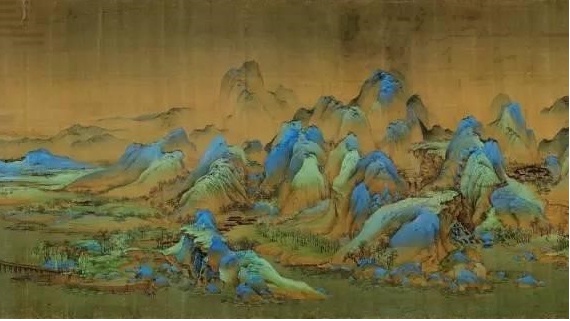
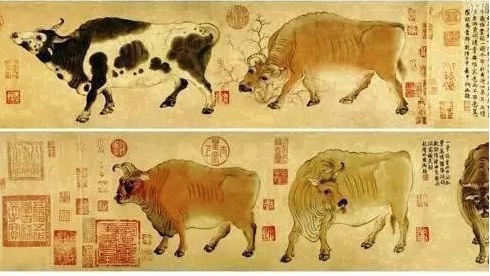
4. Cultural Creation Products
The Forbidden City is one of the seven World Heritage Sites in Beijing; it is also the first choice of tourists to Beijing. Today, the Forbidden City is not only a time-honored cultural heritage site, but also the cradle of much-sought-after cultural creativity products. Don't worry if you haven't had time to buy something while visiting the Forbidden City. It has an official flagship store on Taobao!
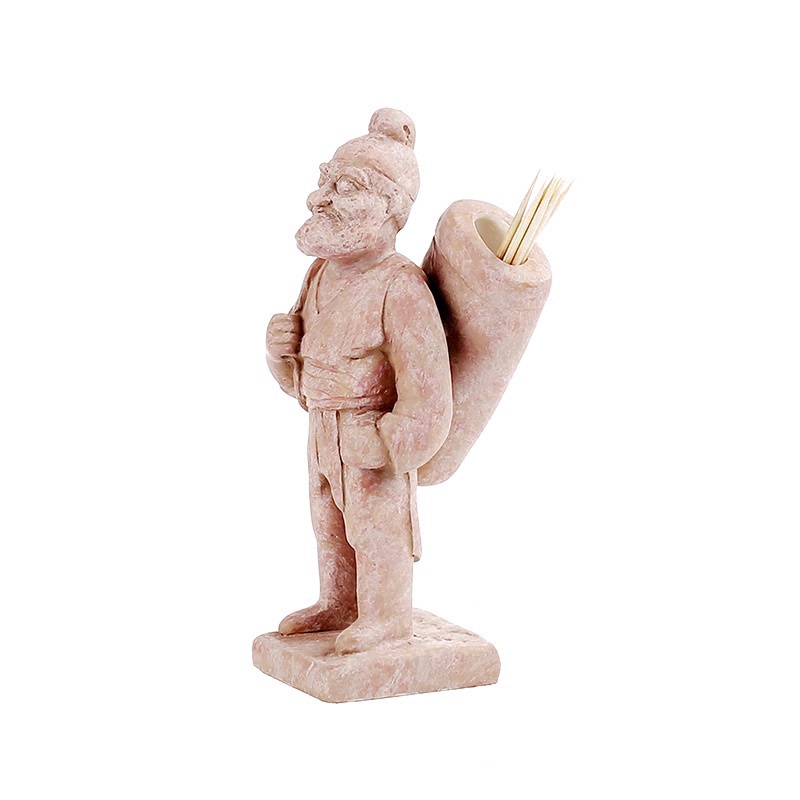
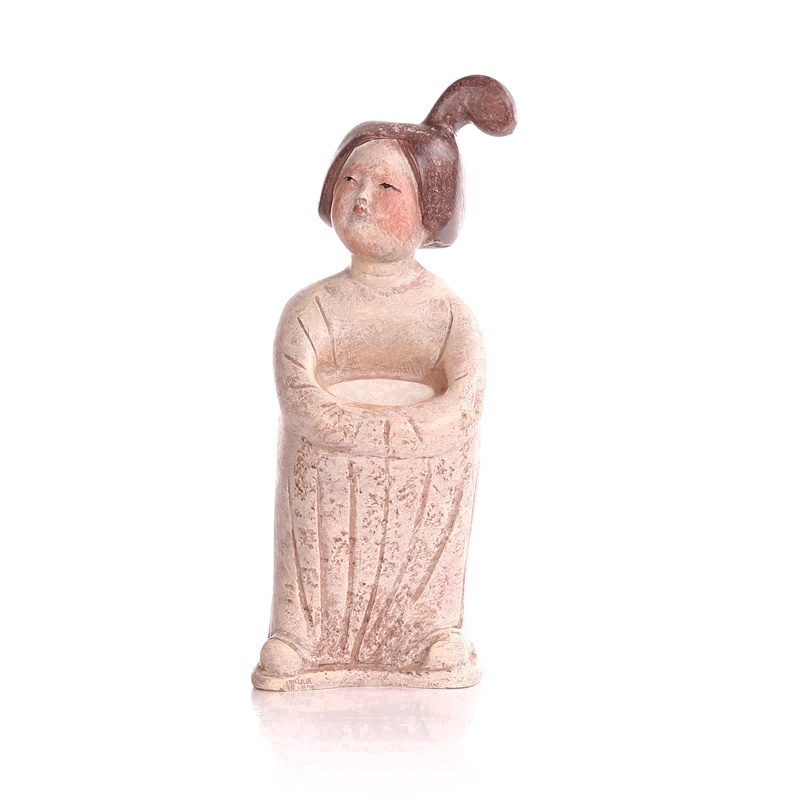
["Yong Shi Xiang Ban" Painted Pottery Figurine] Creative Toothpick
It is said that the creative design of this set of products has its origin in the Tang-Dynasty painted pottery housemaid figurine and the Tang-Dynasty painted pottery Hu figurine collected in the Palace Museum.
Design originality comes from life, and the best production is to continue to apply design creativity in life.
Toothpicks are very common in people's daily life. Although floss and other similar products have already appeared, toothpicks still have a dominant position in China. To hold toothpicks, one must need a toothpick-holder. When consumers make a choice as to what toothpick-holder to buy, whether the shape is exquisite has become a very important criterion. The Tang-Dynasty housemaid figurine and Hu figurine conquered many viewers with their beauty—their plump, graceful profiles and attractive, freehanded look. A toothpick-holder featuring a Tang-Dynasty housemaid figurine or Hu figurine would look elegant and noble on the table.
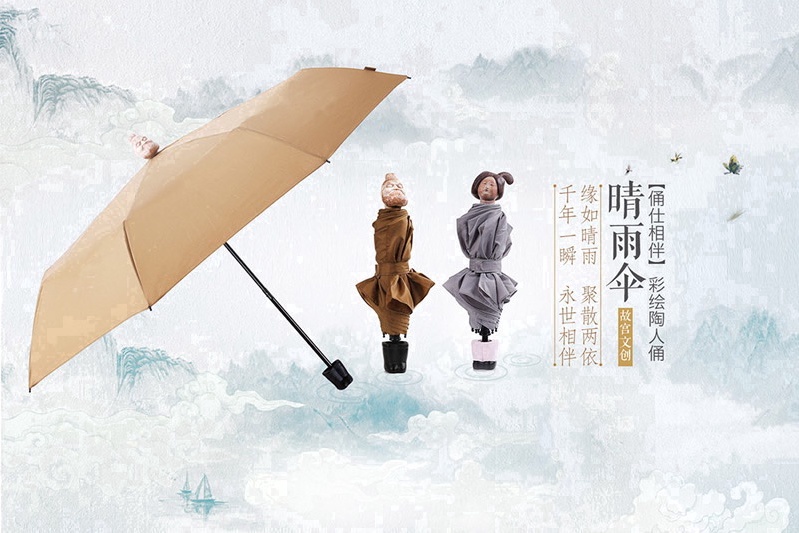
[Yong Shi Xiang Ban] Umbrella with a Painted Pottery Figurine
The creative design of this set of products has its origin in the Tang-Dynasty painted pottery housemaid figurine and the Tang-Dynasty painted pottery Hu figurine collected in the Palace Museum.
In the Tang Dynasty, the unprecedented prosperity of trade played its role in artistic creation, and the image of Hu people began to appear in sculpture.
In the design, the image of a Han Chinese woman and that of a Hu man living in the Tang Dynasty are combined in the making of the umbrella cap and the base of the umbrella holder. Ostensibly, it depicts the beauty of the sculpture of the Tang Dynasty. Profoundly, it implies that love can cross the boundaries between races and territories and that the only thing that matters before a happy ending is the company of the loved one regardless of the weather.
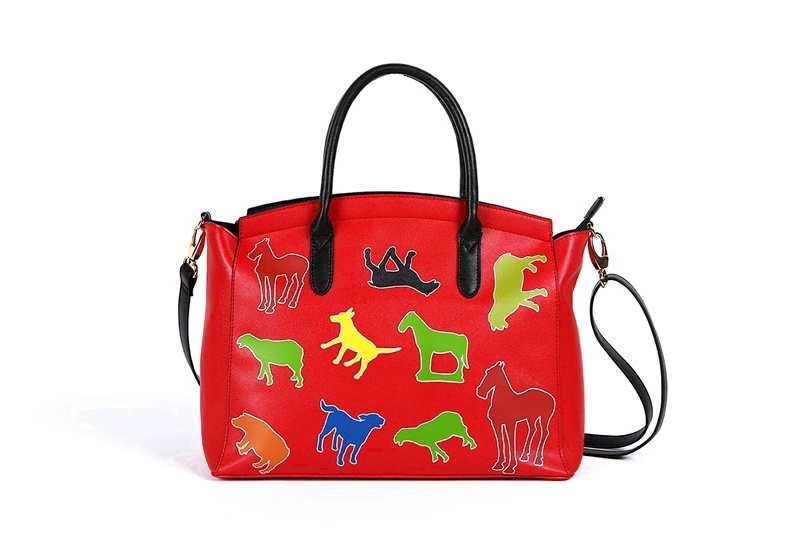
"Innermost Words" Lady Handbag with a Pottery Animal Figurine
The creative design of this set of products has its origin in the Western Han Dynasty painted pottery horse, the Eastern Han Dynasty pottery sheep, the Eastern Han Dynasty pottery young sheep, the Eastern Han Dynasty pottery dog, the Eastern Han Dynasty pottery pig and the Yuan Dynasty pottery horse in the Palace Museum and variant designs. A touch of joyful Chinese red brings out incomparable luck and happiness in the graceful demeanor. Wherever you go, this warm company matters the most—even if you're far away from home. Horses and dogs symbolize loyalty, pigs symbolize wealth, and sheep symbolize good luck. The combination of these elements plus red, the representative Chinese color, delivers a sense of goodness and luck both visually and emotionally. It also symbolizes the beautiful wish of requesting the several cherished animals to pray for users.

Auspicious Vat of the Imperial Palace
The Auspicious Vat of the Imperial Palace refers to a water-filled vat placed in front of the palace for the prevention of fire. In ancient times, it was called "sea in front of the door" to mean that the vat contains enough water to put out fire, hence the name "auspicious vat."
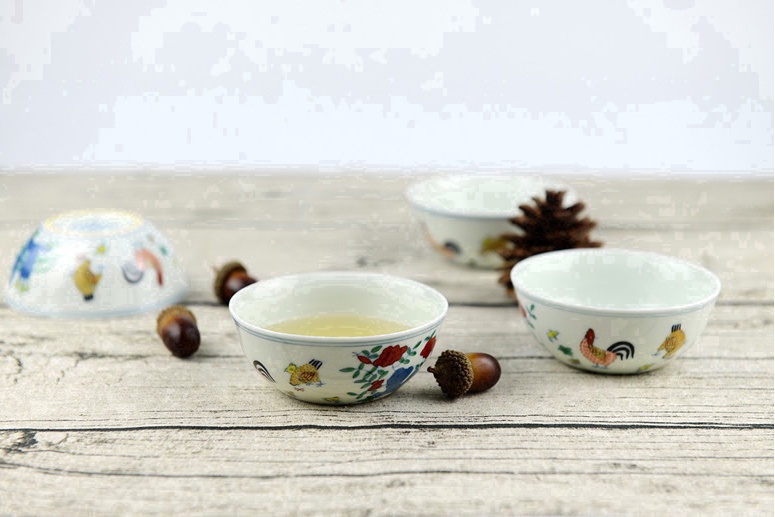
Wine Goblet Painted with Chickens of the Chenghua Era of the Ming Dynasty
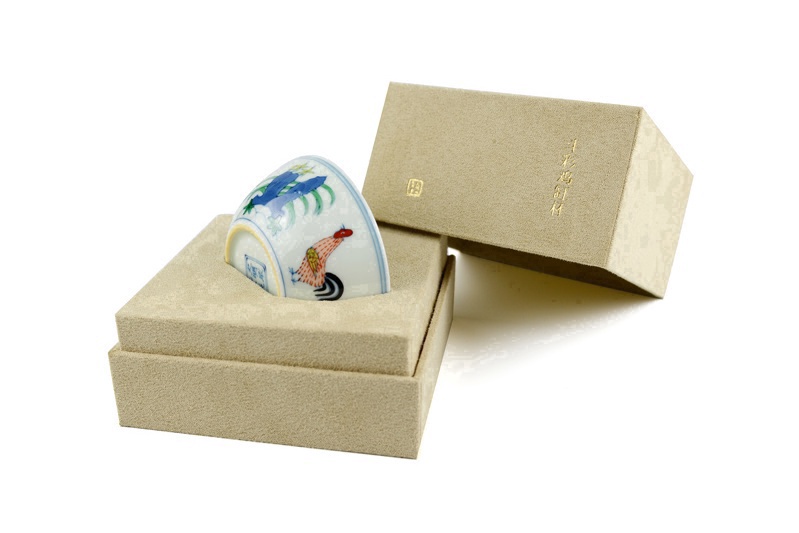
The wine goblet painted with chickens of the Chenghua era of the Ming Dynasty is an artistic treasure among traditional Han ceramics. It was a utensil used by Chenghua Emperor of the Ming Dynasty. This goblet painted with chickens is highly acclaimed for its novel shape, fresh and lovely decoration and exquisite workmanship. It is a utensil typical of the Chenghua era of the Ming Dynasty. Its base is white, delicate, light, and lucid. Its white glaze is soft and smooth on both the inside and outside. The decorative pattern on the outward side matches the shape of the goblet body that looks like a well-organized mass. Color schemes such as underglaze blue and overglaze bright red, leaf green, light green, light yellow, ginger yellow, and black are adopted. Techniques such as coloring, color laying, dyeing and stippling are applied. Blue and white are used to draw lines and dye lake stones. The flowers are bright red, the leaves are aqua green, the chickens are light yellow and ginger yellow, the chicken crest, feathers and wings are red, and the slope is green. In some areas the color is strong, while in other areas it is light. The whole picture is a combination of simplicity and elegance. It is an epitome of the superb color applying techniques that Huang Quan, a painter during the Five Dynasties, used in his bird-and-flower paintings. The whole picture is a lively sketch of nature.
According to historical records, Chenghua Emperor was fond of painting and calligraphy. The scene of a hen looking for food with several chickens in the Song Dynasty painting Mother Hen and Chicks inspired him, who wrote a seven-character poem on the picture to praise the hen's love for the chickens. Perhaps because of this, Chenghua Emperor wished to make a goblet painted with chickens. A scholar explained that Chenghua Emperor's purpose of painting chickens is twofold: first, the first year of the Chenghua era was the Year of the Rooster; second, the Chinese character for "chicken" is homophonic with the character for "auspicious" and drawing chickens was believed to bring good luck and happiness.
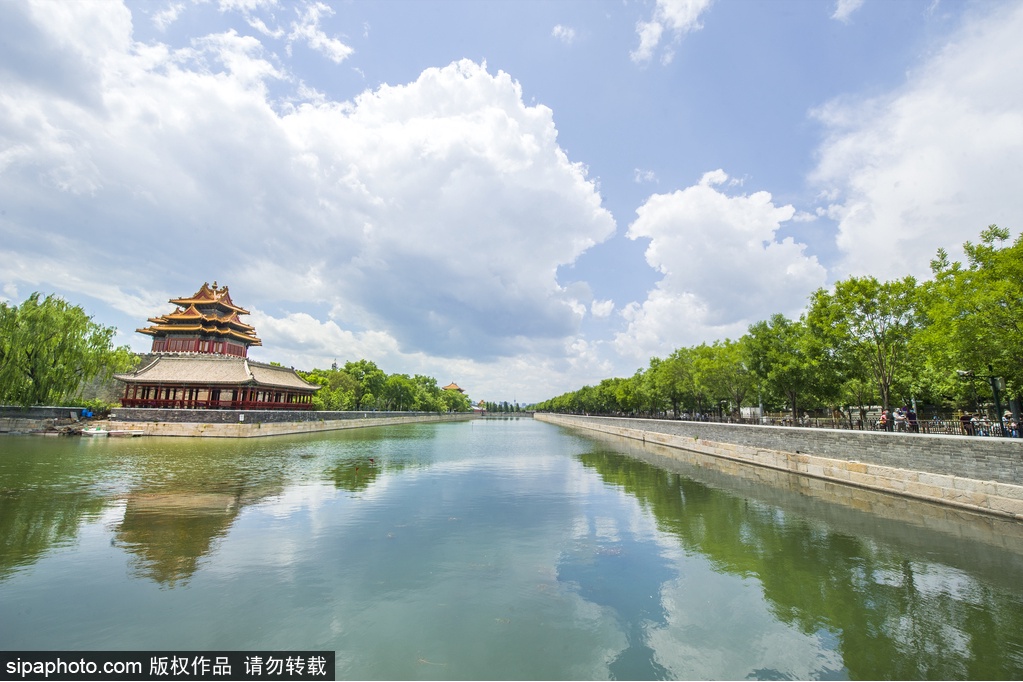
The Best Season to Visit the Forbidden City
The Forbidden City can be visited all year round. Comfortable spring is a good choice to admire flowers in the Forbidden City; hot summer is suitable for indoor tours; autumn is a time when the sky is clear and the air is crisp and is the ideal season to enjoy the red leaves in the Forbidden City; cold winter creates amazing snow sights in the Forbidden City.
Recommended duration of tour: 3-4 hours
Opening Hours
The Palace Museum is open all year round, but the opening hours vary in peak season and low season, and will be extended or shortened during official holidays. Please keep close track of the notices on the official website! If major events or emergencies make it necessary to change the opening hours, the Palace Museum website will make a special announcement. Except for official holidays, the Palace Museum is closed all day on Monday throughout the year.
Peak season: April 1 to October 31
8:30: ticketing service begins; admission allowed
16:00: ticketing service ends (including the Clock Gallery and the Treasure Gallery)
16:10: admission not allowed
17:00: closure of business
Low season: November 1 to March 31
8:30: ticketing service begins; admission allowed
15:30: ticketing service ends (including the Clock Gallery and the Treasure Gallery)
15:40: admission not allowed
16:30: closure of business
Tickets
In the peak season from April 1 to October 31, ticket is sold for RMB 60 (excluding the Treasure Gallery and the Clock Gallery)
In the low season from November 1 to March 31, ticket is sold for RMB 40 (excluding the Treasure Gallery and the Clock Gallery)
Ticket to the Treasure Gallery (including the Palace of Tranquil Longevity, the Opera Gallery and the Stone Drum Gallery): RMB 10
Ticket to the Clock Gallery (the Hall for Ancestral Worship): RMB 10
Admission is free for Children less than 1.2 meters in height with guardians.
Discounted Admission Tickets to the Gate
1. Concessions for elementary, middle school, and undergraduate students on production of valid student I.D. or certified letter from the school administrator (excluding graduate or adult continuing education students): RMB 20 per person.
2. 50% discount on admission for seniors 60 years old and older with valid certificate.
3. 50% discount on admission for holders of certificates of receipt of the minimum living guarantee for urban and rural residents in Beijing on production of valid certificates.
4. Free admission for retired cadres on production of retirement certificates.
5. Free admission for children less than 1.2 meters in height
6. Free admission for disabled visitors on production of disability certificates
7. Free admission for tour guides on production of tour guide certificates
8. Women’s Day (March 8): 50% discount on admission for female visitors
9. Children’s Day (June 1): free admission for children 14 years old and younger; 50% discount on admission for one accompanying parent
10. Army Day (August 1): free admission for active servicemen on production of valid certificates
Discounted Admission Tickets to the Clock Gallery and the Treasure Gallery
I. Specific groups can enjoy 50% discount on admission (RMB 5 per person), including:
1. Elementary, middle school, and undergraduate students (including those from Hong Kong, Macao and Taiwan) on production of valid student I.D. or certified letter from the school administrator (excluding graduate or adult continuing education students);
2. Minors aged between 6 (excluding 6) and 18 (including 18) on production of valid certificates;
3. Seniors over 60 years old (including 60) on production of valid certificates;
4. Holders of certificates of receipt of the minimum living guarantee for urban and rural residents in Beijing on production of valid certificates.
II. Specific groups can enjoy free admission, including:
1. Children under 6 years of age (including 6) or under 1.2 meters in height (including 1.2 meters);
2. Disabled visitors on production of disability certificates;
3. Retired cadres on production of retirement certificates;
4. Tour guides on production of tour guide certificates.
III. Discounted Admission Tickets on Special Holidays, including:
1. Women’s Day (March 8): 50% discount on admission for female visitors, RMB 5 per person;
2. Children’s Day (June 1): free admission for children 14 years old (including 14) and younger, and 50% discount on admission for one accompanying parent, RMB 5 per person;
3. Army Day (August 1): free admission for active servicemen on production of valid certificates.
Traffic Routes
Meridian Gate (the south gate of the Palace Museum that has been used as the visitor entrance only since July 2, 2011) can be reached from Tian'anmen Square via Gate of Correct Deportment, or from East Prosperity Gate or West Prosperity Gate via East Tongzihe Road or West Tongzihe Road.
Public transport station(s) in the proximity of Meridian Gate: Tian'anmen Square East Station; vehicles that pull off here: Bus 1, 120, 2, 52, 59, 82, and 99, Night Bus 1, Night Bus 2, Night Bus 17, Sightseeing Bus 1, Sightseeing Bus 2 and Metro Line 1
Public transport station(s) in the proximity of Meridian Gate: Tian'anmen Square West Station; vehicles that pull off here: Bus 1, 5, 52, and 99, Night Bus 1, Sightseeing Bus 1, Sightseeing Bus 2 and Metro Line 1
Address: No.4 Jingshan Front Street, Dongcheng District, Beijing



